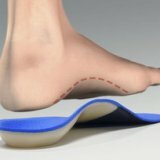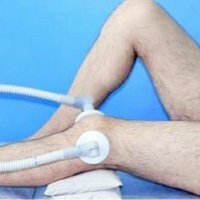Flatfoot: a description of the disease
 Flat-foot refers to the acquired or congenital condition, in which the arch of the foot is omitted - a physiological bend that reduces the load on the bones of the foot during walking. Flat-footedness: a description of the disease is the topic of the conversation for today.
Flat-foot refers to the acquired or congenital condition, in which the arch of the foot is omitted - a physiological bend that reduces the load on the bones of the foot during walking. Flat-footedness: a description of the disease is the topic of the conversation for today.
General information
Normally, in a straight person standing, the central part of the feet touches the floor surface only on its outer border. In people suffering from flat feet, the foot can touch the floor throughout the area.
Flattening is rarely congenital - only in 3% of cases. Even more rarely, flat feet arise due to traumatic foot injuries. Sometimes the cause of this disease is a number of other concomitant diseases - rickets, diabetes, poliomyelitis. The most frequent cause is the presence of a constant excessive or insufficient load on the legs.
Flat-footedness is much more common among residents of developed countries than in developing countries. This is primarily due to the daily use of shoes. Studies have shown that the sooner a child begins to wear dense shoes, the more he has a chance to earn a flat foot in the future. Among people who went barefoot up to the teenage period( studies were conducted in India), the incidence of flat feet is just under 2%.In Europe and the USA, 75% of the population suffer from this disease to varying degrees.
Causes and Symptoms
The description of the disease will not be complete without indicating its causes and symptoms. In the foot, two arches are distinguished: transverse and longitudinal. The longitudinal arch is located on the inner surface of the foot, and the transverse one at the base of the toes. These arches are designed to amortize the body when walking and help maintain balance. If the foot is flattened, the body weight during walking is shifted directly to the entire spine and joints in the lower limbs. This is a very big load for these departments, which is why flat feet accompanies the development of scoliosis and arthrosis.
To prevent flat feet develop, it is necessary to give a constant load to the muscles and ligaments of the foot. Especially useful is walking on hard grass, sand and stones. Without regular training, the muscles of the foot, like any other, lose strength and do not support the foot in the former normal state. This leads to a flattening of the foot.
Congenital flattening of the feet is usually caused by a development of connective tissue. At the same time, along with congenital flat feet, there is myopia, hyperbolus of the gallbladder, additional chords in the heart and other pathologies.
One of the main factors in the development of acquired flat feet is incorrectly selected footwear, especially in early childhood. You can not let a child wear other people's shoes, especially small ones, because stretched and out-of-shape shoes do not correctly distribute the load to the foot base. In children's shoes, there must be a small heel, the back should be rigid, and the arch supports soft. This will compensate for the lack of unevenness in the form of bumps and pebbles under your feet, and help to properly form a foot.
In adults, large loads on the legs can lead to the development of flat feet. For example, it can be a lot of body weight, a long stay on your feet during the day or being in a monotonous position( standing).Also, the development of flat feet is possible during pregnancy, when wearing high-heeled shoes due to the fact that the fulcrum is transferred from the entire foot to the metatarsal bones.
The easiest way to diagnose the flatfoot is the imprint of your foot. Apply a little greasy cream on the inner surface of the foot and try to stand on a sheet of paper. In order for the test to pass properly, it is necessary to stand evenly, leaning on the entire foot. Normally there is a groove on the inside of the foot that will not leave a print - it takes up most of it on the foot. If there is no such indentation on the print, or it is narrow( less than half of the entire width of the foot), then almost the entire sole is imprinted on the piece of paper. This gives grounds for the diagnosis of "flat feet".
Apart from these there are also following symptoms of this disease
- Tenderness of the feet at the end of physical exertion( at the first stage of flatfoot);
- Fatigue and swelling of the legs in the evening;
- Pain spreads higher from the foot to the knee( in the second stage);
- Tenderness in the lower back, walking in shoes causes a significant inconvenience. Pain in the legs is accompanied by incidental headaches( in the third stage);
- Because of the wide foot it is impossible to walk in familiar shoes;
- Heels last longer stitching on the inside.
These symptoms are not always just signs of flatfoot, they can also manifest in the presence of endocrine and cardiovascular diseases. Therefore, it is absolutely necessary to consult a doctor.
Treatment of flat feet
This disease can be cured only at an early age. In adults, you can only slow down the developing flat feet, the description of the same treatment methods is described below.
Fixation of flatfoot is a strengthening of the ligamentous apparatus and the muscles of the foot, protection in the whole whole of the body and protection of the spine from exorbitant loads, prevention of the development of arthrosis in the joints of the feet, deformation of the fingers and the occurrence of diseases of the spine.
The feet must necessarily be trained. It is not necessary to underestimate flat feet in this sense, diseases can not be given to develop. You can make contrasting baths, it's good in terms of massage treatment, doing exercises or even just walking on an uneven surface. Also, the therapeutic effect is the evening hot baths with an extract of conifers, chamomile infusion or sea salt. They well toned feet. At the end of the procedure, the legs need to be poured with cold water or wipe feet with a piece of ice - this perfectly removes fatigue.
It is useful to learn how to do a therapeutic foot massage. You need to start it with strokes, then knead with your fist or thumb. Then you need to vigorously stretch the sole, moving along the inner edge from the heel to the toes, then along the outer edge and the middle.
Exercises for flattening the foot should be performed at least 10 minutes a day. Bed in the bathroom massage mat. During the day, several times take off your shoes and get up from the heel to your toe. You can just stand for a while on the outer edge of the foot.
For the prevention of flatfoot and relief of pain using special insoles for arch supports. They act as shock absorbers, giving the foot a normal position. Correctly choose the right kind, size and lift of the arch supports the orthopedist.



